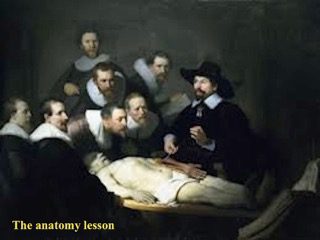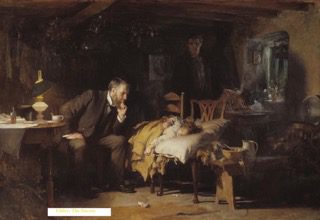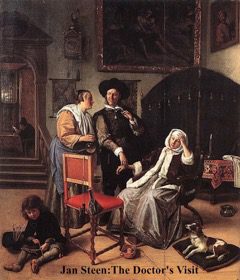JMS Pearce
East Yorks, England

Art has been said to deepen compassion for suffering.1 Paintings have been interpreted as “metaphors for human feelings . . . they are nonliteral symbols of the inner life.”2 Paintings trigger emotions and insights, “generating associations and tapping new, different, or deeper levels of meaning.”3 It is inherent in all the arts that interpretation such as these relies on individual past experiences, emotions, knowledge, and moods: all variable features and almost entirely subjective. Art has the power to record reality as well as fantasy.
Observation is essential to the creation of art. Artists generally try to convey human experience or reflect the pathos, humor, joys, or plight of their subjects.4, 5 This may be suffering and illness, with the patient as the main object, or it may portray the doctor’s attention to the patient, and more subtly the emotions he may be experiencing in the face of an intractable disease or in attempting to provide hope and comfort to the sufferer and family. A classic example is David Willkie’s A bedridden sick young woman being examined by a doctor, accompanied by her anxious parents. (Engraving, 1838).
The artist’s principal tools are imagination and particularly “observational art” which often aim to show faithfully or figuratively and to interpret scenes with creative license to tell their story. Abstract art can also represent illnesses and physicians, but demands more complex interpretations from the viewer.
It may be of interest to glance at three of the best known pictures portraying physicians at work and the predicaments of their patients.
Rembrandt’s The Anatomy Lesson of Dr. Nicolaes Tulp (1632)
The first introduction to medicine for most physicians was the dissecting room. The Netherlands had a distinguished tradition of anatomy, established by Andreas Vesalius (1514-64). Rembrandt van Rijn (1606-69) from his earliest years—like Darwin and Charles Bell—attempted to relate the play of facial expression into a variety of emotions. Nicolaes Tulpius (Tulp) (1593-1674) was Praelector from 1628 to 1653, whose annual duty was to lecture for the members of the Surgeons’ Guild of Amsterdam, during which the corpse of an executed criminal would be dissected. The practice was for the praelector to have his portrait painted with other members in attendance. And so, in 1632, Tulp’s friend Rembrandt immortalized him in The Anatomy Lesson, to be seen today in the Rijksmuseum.
The son of a merchant in Amsterdam, Tulp was born Nicolausi Pietersz Dirksz in 1593. He studied under Pauw and Bontius at Leiden. He changed his name to Tulpius, adopting the fabulously expensive tulips which adorned the facade of his home on Keizersgracht, Amsterdam, with an engaging charm and choice of name which today would appear eccentric. A fine anatomist, pathologist, and physician, Tulp provided early descriptions of the ileocecal valve (Tulp’s valve), angina interna, kidney stones, a bronchial cast, beriberi indorum, and tapeworms. His “golden work” (Haller) was Observationum medicae 1641.6

Rembrandt’s masterpiece shows Tulp in formal dress with a lace collar and tassels, dissecting the forearm of the corpse in order to demonstrate the workings of the muscles to the commissioning Guild. It captures the dissection and lecture he delivered on 31 January 1632. In addition to Tulp, the portrait features seven members of the Surgeon’s Guild, each of whom would have paid commissions to be included in the picture, as well as the corpse of the robber Adriaen Adrienszoon, who had been hanged that day. In the bottom right is a large textbook on anatomy, almost certainly De humani corporis fabrica (1543) by Vesalius, with whom Rembrandt flatteringly associates Tulp. We can see the intense curiosity of the onlookers and their proximity to the corpse.7 Unlike similar portraits, Rembrandt minimizes anatomical detail, and focuses on the facial expressions and perhaps the emotional reactions of the dissector and his audience. The Anatomy Lesson won immediate praise and confirmed Rembrandt as a master painter. It was the first known time he signed a picture with his forename instead of his usual RHL (Rembrandt Harmenszoon of Leiden), which suggests his growing confidence. The work hung in the Anatomical Theatre of the Amsterdam Surgeon’s hall in the Nieumarkt until 1828, when it was bought for the Mauritshuis Royal Picture Gallery by King William I. (Fig 1).
The Anatomy Lesson warns of the connection between criminality and death, thus signalling the transience of earthly life. W. Shupbach asserted in his Rembrandt’s Anatomy of Doctor Tulp (Wellcome Institute, 1982) that Rembrandt was also probably referring to Tulp’s attachment to a religio-medical tradition, which regarded the hand as the supreme instrument bestowed by God on the human. This was allied to the notion that since the body was God’s creation, the art of anatomy was a link to the knowledge of God. Others have argued that Tulp’s vanity persuaded Rembrandt to link him to Vesalius.8
Sir Luke Fildes’s The Doctor
A graver picture by Luke Fildes (1843-1927) nostalgically illustrates the pain and grief of a family over their desperately ill child. In 1890 Sir Henry Tate (1819-98) commissioned a painting from Fildes, who was to choose the subject. He chose the tragedy of his son Philip.9 Fildes’s other son (Sir Paul Fildes FRS., (1882-1971)) an eminent bacteriologist and biographer wrote:
“The character and bearing of their doctor throughout the time of their anxiety, made a deep impression on my parents. Dr. Murray became a symbol of professional devotion which would inspire this painting.”
The picture (Fig 2) itself gives no clues as to the nature of the illness, but Fildes probably here recalls a personal tragedy when his son Philip died at the age of one, supposedly from tuberculosis. The doctor bears some resemblance to Fildes himself. The child was painted from studies of the head of his daughter Phyllis.10
This painting (exhibited in 1891 at The Tate) shows a doctor deep in thought, observing an ill child laid on a makeshift bed constructed out of two non-matching chairs pushed together, while the father looks on in despair, consoling his wife with his hand on her shoulder. The doctor is watching over a poor laborer’s sick child; the cottage interior is humble, befitting the laborer’s status. The father in the background looks into the grave face of the doctor. The pewter, the scrap of carpet on the stone floor, and the family’s ragged clothing show their humble lifestyle. Fildes described the shaft of daylight as signifying the imminent recovery of the child. He wrote: “At the cottage window the dawn begins to steal in – the dawn that is the critical time of all deadly illnesses – and with it the parents again search for hope.”11
Fildes’s skillful use of light and perspective focuses the eye on the doctor, the patient, and the relationship between them.12 The father looks on, powerless to intervene, and the mother has collapsed but accepts succor from the hand of the more powerful man. “The doctor broods, but was almost as helpless as the parent only six feet and three or four social classes away”, writes Douglas.13
As medicine was largely ineffective and specific cures rare in the mid-19th century, the doctor’s treatment was unlikely to have had much influence on the malady. Douglas continues:
“So his manner is all, and Fildes captures it forever: the furrowed brow; the hand propping the firm bearded chin; the calm, concerned authority.”
The picture received much praise from contemporary critics and was well-received in the British Medical Journal in 1892:
“What do we not owe to Mr Fildes for showing the world the typical doctor, as we would like to be shown — an honest man and a gentleman, doing his best to relieve suffering? A library of books in our honor would not do what this picture has done . . .”14
A cynical view regards Fildes’s portrayal as neither realistic nor historically accurate.15 The Doctor reminds us of the relationship between patient and doctor. It illustrates the power of bedside manner. Fildes told later of his desire to “put on record the status of the doctor in our time.”16 The Lancet celebrated the 50th anniversary of the National Health Service by reproducing the image of The Doctor in a celebratory issue.
Jan Steen’s The Doctor’s Visit
A more lighthearted portrayal of medicine is often evidenced in caricatures and cartoons showing doctors mystified by their patients, their remedies (which now seem ridiculous), and by their apparent sadness or bewilderment, often while gazing at urine samples. A colored lithograph c. 1850 by James Morrison titled A patient after receiving ‘heroic treatment’, in the form of amputation of all limbs, bears the caption: “This is how I looked after what the doctors call HEROIC TREATMENT.”

A classical example is the Doctor’s Visit, in the Wellington Collection, London. Jan Havickszoon Steen (1626-79) tended to make daily life the principle subject in his paintings, but also painted historical, mythological and religious scenes, portraits, and genre scenes. Steen is known for his entertaining and moralizing pictures of contemporary Dutch life. One of his favorite themes was the doctor’s visit, usually to a young woman suffering from love sickness or pregnancy.
The Doctor’s Visit (Fig 3) contains several clues to the probable cause of the malady of the attractive and elegantly dressed young lady: she is not ill but lovesick. For emphasis, there is a picture of Venus and Adonis on the wall and the boy in the foreground is Cupid in 17th century costume, putting an arrow in his bow. The doctor takes the woman’s pulse and looks knowingly at the maid, who is holding a urine bottle. Erotic melancholy was allegedly detected by feeling the pulse, whilst visual examination of the urine was claimed to show the same disorder, or pregnancy. A brazier at the girl’s feet contains a ribbon from her garments. The odor of the singed ribbon was used as smelling salts to revive a swooning patient.
The melodrama of the patient is mocked as is the pretentious demeanor of the doctor, who may be missing the true diagnosis. Steen emphasizes the point by giving the doctor an outdated, theatrical costume, and by Cupid smiling knowingly at the viewer. Contemporary jokes also ridiculed doctors for their inability to diagnose pregnancy, here indicated by the pregnancy test of a ribbon dipped in urine. Another artistic jest at the expense of the doctor is seen in the Wellcome Library’s colored lithograph after C. Philipon, c. 1830, in which A besotted physician asks his young patient to cure him of his heartache.
Steen returned to this theme many times, notably in The Doctor’s Visit, c.1660, in the Hermitage; and The Doctor’s Visit, c.1660, in University of Edinburgh Fine Art Collection, where the lovesick patient’s doctor simulates mock-humility as he accepts a glass of wine from a servant, her lover shown in the background. There are many comparable pictures of Steen’s The Doctor’s Visit. The same title was also used by fellow Dutchmen Egbert van Heemskerk in 1725 and by Frans van Mieris the Elder in 1667. Steen also painted A Physician Taking a Woman’s Pulse on several occasions.
Discussion
Many great artists infused life into their pictures for our pleasure. Experts’ interpretations of pictures are sometimes portentous displays of their authors’ assumed depth of artistic knowledge and understanding. However, several medical schools have started courses to train doctors in observational skills by studying great art. This practice purports to help them to become more observant, inform them about how society views medical conditions, and connect them with the craft of medicine at a time when it is increasingly technological.17 Art may help us recognize the plight and emotions of patients in order to enhance understanding and rapport. But if sensitivity and compassion are lacking in the student or doctor, art is unlikely to change his or her sentiments.
Art may seek to enhance the physician-patient relationship and may attempt to visually describe aspects of illness in an expanded vision of reality. But in such a subjective portrayal of life’s issues, both sad and comical, it might be less pretentious to argue that art stands in its own right but reflects important aspects of doctors and their patients’ illnesses. To what extent this may influence medical attitudes and practices remains conjectural.
Captions
- Fig 1. Rembrandt’s Dr. Nicolaes Tulp The Anatomy Lesson. 1632. This work is in the public domain in its country of origin and other countries and areas where the copyright term is the author’s life plus 100 years or less.
- Fig 2. Sir Luke Fildes’s The Doctor. This work is in the public domain in its country of origin and other countries and areas where the copyright term is the author’s life plus 80 years or less.
- Fig 3. Jan Steen’s The Doctor’s Visit 1658-1662. This is a faithful photographic reproduction of a two-dimensional, public domain work of art. The work of art itself is in the public domain in its country of origin and other countries and areas where the copyright term is the author’s life plus 100 years or less.
Note
- Variously spelled Nicolaas, Nicolaes, and Nicolaus
References
- Karkabi K, Cohen CO. Deepening compassion through the mirror of painting. Medical Education 2006; 40:462.
- Feinstein H. Reading Images: Meaning and Metaphor. National Art Education Association 1996; 45-55.
- Schidlow DV, Gelo F. Verdi and Velázquez: perceptive sensitization in clinical medical education. Hektoen International Fall 2015
- Cawthorne T. Medicine in Art. (Presidential Address to the Harveian Society of London) Postgrad Med J 1961;37:184-90.
- Rose FC. Neurology of the Arts: Painting, Music, Literature. Chapter 3: 43-76. edited by F Clifford Rose
- Tulp NP. ObservationesMedicae; Ed 5. Leiden, Vivie 1716.Book 1, Ch 13
- Lindeboom, GA. Medical aspects of Rembrandt’s anatomy lesson of Doctor Tulp. Janus Leiden 64 (1977): 179-203.
- Mitchell D. Rembrandt’s “The Anatomy Lesson of Dr.Tulp”: A Sinner among the Righteous. ArtibusetHistoriae. 1994;15:145-156.
- The Famous Artists: Luke Fildes. http://www.thefamousartists.com/luke-fildes. Accessed 29 )ct 2015
- Birchall H. Sir Luke Fildes, The Doctor exhibited1891. @ Tate London,.September 2003
- Wilson S. Tate Gallery: An Illustrated Companion, London 1997, p.90.
- Barilan YM. The Doctor by Luke Fildes: an icon in context. J Med Humanit. 2007; 28(2):59-80.
- Douglas C. Doing better, looking worse. BMJ. 2002;325:720.
- Banks W M. Doctors in literature. BMJ. 1892;8:787–788.
- Moore J. What Sir Luke Fildes’ 1887 painting The Doctor can teach us about the practice of medicine today. Br J Gen Pract. 2008; 58(548): 210–213.
- The Times.Doctors and Surgeons in Art. 17 March 1959: 13.
- Shapiro J, Rucker L, Beck J. Training the clinical eye and mind: using the arts to develop medical students’ observational and pattern recognition skills. Medical Education 2006: 40.3: 263-268.
JMS PEARCE, MD, FRCP, is a retired neurologist and author with a particular interest in the history of science and medicine.
Highlighted in Frontispiece Spring 2017 – Volume 9, Issue 2

Leave a Reply